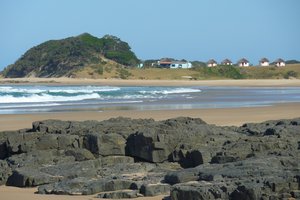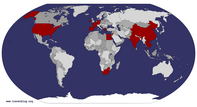Advertisement
Published: August 18th 2010

 Bulungula Lodge
Bulungula Lodge
Strolling on a quiet beach looking back on our lodge. We stayed in one of the pink huts,We spent the past three days at
Bulungula Lodge. It is an eco friendly lodge owned and run by a Xhosa village called Nqileni. It is a Backpackers (aka a youth hostel) but was more mellow than your typical hostel.
We took Greyhound to the city of Mthatha where we were picked up a shuttle from the lodge. The shuttle was a covered Land Rover pickup with seats in the back. I could tell by the dust everywhere that we were in for a rough ride. The first hour was on paved streets but the last 1.25 hours was on rough dirt road. The driver sped along these rough roads at 50mph. He was constantly avoiding animals such as dogs, chickens and cows as well as people. But he never hit anything and we arrived right at sunset.
We met our host who showed us to our room then gave us the instructional tour: how to order food; how to get a drink from the bar; how to use the
composting toilet; and how to use the
rocket shower. Our room is a classic round hut about 20’ in diameter. It has two windows and a horizontally split door. The outside is

 Xhosa Child 1
Xhosa Child 1
Child posing for the camera.painted faded pink; the inside is a peach with stylized birds painted on it. The floor is made of a cow dung mixture so is spongy and there are three woven mats on the floor. The only furniture is one king size bed and one twin bed where we put our packs. There are two rods to hang things hanging from the ceiling. The ceiling/roof is the classic thatched roof except there is a light and a light switch. There is also a driftwood mobile hanging from the ceiling.
The next day I arose about sunrise and it was such a beautiful morning that I decided to take a walk along the beach. It was quite pretty with the sun rising over the ocean. In addition, there are hundreds colorful and beautifully shaped shells along the beach as well as coral and sponges that washed ashore.
They have several excursions available such as a tour of the village and horseback riding. The only one John wanted to do was canoeing so we siged up. Our guide, Likey, arrived about 30 minutes later. Likey is 21 years old but is still in school and has three years to go.

 River Guide
River Guide
Likey, our river guide showing how to live life properly.During the walk to the river, Likey twice asked us to take pictures of children…they like to pose then see themselves on the screen. At the river, John and I got in one canoe and Likey in another. Likey did not really guide just stayed mostly within sight. At one point, he pulled onto the bank, got out of his canoe and laid down for a nap. We kept paddling until rocks blocked the river then joined him on the bank for a nap. After about 30 minutes we climbed back in the canoes and headed in.
After getting back to the boat launch, we went to lunch at Inala’s Fire Restaurant. I descrbed the place in my blog entry about food.
After lunch, we returned to the lodge then headed down to the beach. We walked along the beach for about two hours playing in the tide pools, looking at shells and just watching the ocean. Then back to the room to get clean clothes and to the shower house to take a rocket shower.
A rocket shower is a chimney which heats water. You put TP in a hole at the bottom, add about ½

 Village
Village
Picture of part of the village by the ocean.cup liquid paraffin then light it. While it burns (about 8 minutes) you have hot water. It roars like a rocket, hence the name.
The next day John relaxed and I arranged for a guide to give me a quick exploration of women’s duties in Xhosa culture.
We started out at her cousin’s house where she painted my face with a clay mixture; this acts both as a sunscreen and is considered becoming. She also put on the “foundation” on her own face but didn’t put on the decorative coloring. Then we went to fetch water from the creek. She carried a five gallon bucket and gave me one that held about one gallon. It wasn’t a long walk - only about three hundred yards but it was downhill and therefore uphill on the way back. To fill the bucket, she used the bucket to scrape the leaves out of the way and then just dipped it full. She dipped mine as well as hers and then we headed back up the hill with the buckets on our heads. She could carry the bucket without holding on to it when there was no wind. I needed to hold

 Beth and Khuluwa
Beth and Khuluwa
Beth wearing makeup put on by Khuluwa.the bucket all the time but I still carried it on my head. When we got back to the hut she put the water into the kitchen.
The “house” of this family consisted of three buildings: a round hut which was the kitchen where we spent our time; another round hut where the children of the family slept; and a square house where the parents of the family slept. I saw only the kitchen. The kitchen hut was your standard hut with cement walls and a tin roof. It was about 20 feet in diameter. It was furnished with a twin bed that was used as a couch, two plastic picnic chairs, and three tables used as counters. There were bags of children’s clothing that were used for kitchen duties, as well as clothing children. There was a one burner stove on the floor which I saw used to heat water for tea. There were also several of the ubiquitous black pots. They are cast iron and have three legs that raise tem about three inches off the ground so a fire can easily be built under them.
The next chore was to go to the “forest” to

 Sunrise over the Indian Ocean
Sunrise over the Indian Ocean
Beth watching the day begin from the top of a sand dune.get wood. I put quotes around forest because although she called it a forest it was really more of a thicket. She took two children shirts from the bag and we walked to the thicket which was next to the creek. We each gathered about 20 sticks then tied them together using the children’s shirt. We balanced our bundle on our head for the walk back to the hut where we left the wood at the fire pit.
Now it was time to heat lunch. The biggest of the black pots contained a mixture of cooked maize and beans. She cleaned out one of the smaller pots using the creek water and a corncob as a scrubber. Then she scooped quite a lot of maize and beans into the clean pot and added a couple of cups of creek water. We went outside to build a fire then left the pot on the fire to heat. After about 30 minutes, she stirred it with a hand carved stirring stick then took it inside to serve. To serve, she put a mound on a plate, added oil and salt, stirred and served.
I had trepidations about the creek water

 Village Houses
Village Houses
Another view of the village from the sand dune.but it had been boiling for at least 20 minutes so I gave it a try. It was tasty and similar to sticky rice and beans. She gave me a large serving which I could not finish.
After lunch she showed me how to grind corn using a matate and mano. It is harder than it looks; I would probably starve before I could grind enough to feed myself.
During this entire time, she was good about answering questions such as where do they store food (what little they store is in the kitchen) and what do they use the sheep for (they sell the wool and eat the mutton on special occasions or happy days). We had an interesting conversation when I asked if they drank milk and she replied “yes, in tea.” When I asked if the children drank it, she looked at me like it was completely unthinkable. She has a six year old son but does not like the restrictions of marriage so refuses to get married. She was surprised to learn I was 45 but had no children. Another woman I spoke to could not grasp not having children; “who will take care

 Xhosa Child 2
Xhosa Child 2
Note the cellphone as fashion accessory. of the house when you are old?”
After returning, John and I took another walk on the beach.
Our final morning we set our alarm and got up at 5:30 to watch the sunrise. It was just starting to glow as we walked along the beach. We watched the sun rise out of the ocean and also scanned the ocean for dolphins. The sun did indeed rise although it was partially obscured by an incoming weather front. The dolphins, however, did not put in appearance. We did, however, see a fisherman.
No doubt Bulungula was a highlight of our trip in South Africa; it was educational, beautiful and relaxing all at the same time.
Advertisement
Tot: 0.064s; Tpl: 0.011s; cc: 13; qc: 28; dbt: 0.0279s; 1; m:domysql w:travelblog (10.17.0.13); sld: 1;
; mem: 1.1mb











Kathy Cissna
non-member comment
Beautiful
Beth, thank you so much for chronicling your trip, both in terms of what you're doing and what you're learning about each place. What a rich experience you and John are sharing!